Defender Of The Crown
 The Game: The King of England has been assassinated and the crown has gone missing! To regain the crown and restore order you’ll need to conquer the entire country, one castle at a time. Equal parts strategy and action make for lots of fun and replayability. The ultimate cinematic experience for the Commodore 64. (Cinemaware, 1987)
The Game: The King of England has been assassinated and the crown has gone missing! To regain the crown and restore order you’ll need to conquer the entire country, one castle at a time. Equal parts strategy and action make for lots of fun and replayability. The ultimate cinematic experience for the Commodore 64. (Cinemaware, 1987)
Memories: In 1986, Cinemaware released Defender Of The Crown for the Commodore Amiga, introducing a new style of game to home computer owners. Equal parts movie, strategy and action, Cinemaware called their new style of games “Interactive Movies”. Defender Of The Crown begins like a real Hollywood experience, complete with opening credits and a montage explaining the game’s backstory. The Amiga version’s graphics were literally mind-blowing. No one had seen graphics like that before on a home computer, and gamers were convinced that the game would not appear on any other platform. Commodore 64 owners got their wish one year later, when Cinemaware ported the game over to the Amiga’s 8-bit little brother.
Slam Dunk Super Pro Basketball
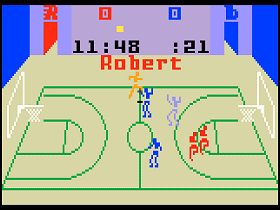 The Game: One or two players can set a budget and begin recruiting a top-notch basketball team (or, alternately, recruiting from who’s left after someone else has recruited a top-notch basketball team), and then it’s time to hit the court. Each player controls a team of three with offensive and defensive moves; the player can control any member of his team. (INTV Corp., 1987)
The Game: One or two players can set a budget and begin recruiting a top-notch basketball team (or, alternately, recruiting from who’s left after someone else has recruited a top-notch basketball team), and then it’s time to hit the court. Each player controls a team of three with offensive and defensive moves; the player can control any member of his team. (INTV Corp., 1987)
Memories: Several of the “Super Pro” sports games released by INTV Corp. – the entity that took on the task of continuing software support for the Intellivision long after Mattel Electronics had given up on the system in the face of the then-looming video game industry crash – began life as re-coded single-player versions of existing Intellivision sports titles. Slam Dunk is an example of a game that diverged completely from the code of its two-player-only predecessor (NBA Basketball).
Pole Position
 The Game: Prepare to qualify! Fly to the finish line in a fierce field of Formula One competitors in a qualifying lap. Leaving the track is trouble – and hitting one of the billboards dotted around the edges of the Mt. Fuji track is a sure way to miss out on the subsequent race. (INTV Corp., 1987)
The Game: Prepare to qualify! Fly to the finish line in a fierce field of Formula One competitors in a qualifying lap. Leaving the track is trouble – and hitting one of the billboards dotted around the edges of the Mt. Fuji track is a sure way to miss out on the subsequent race. (INTV Corp., 1987)
Memories: Pole Position has suffered a few indignities before; an arcade game that was a huge evolution for first-person racing and boasted stellar graphics is bound to hit a few speed bumps on the drive home. But the Intellivision version of Pole Position is a gigantic pothole that’s likely to relieve most players of their drive to recreate the arcade experience.
Jr. Pac-Man
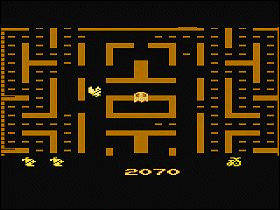 The Game: As the offspring of a round yellow creature consisting of a mouth and nothing else, you maneuver around a bigger maze than your parents ever had to deal with, gobbling small dots and evading four colorful monsters who can eat you on contact. Six large flashing dots in the maze enable you to turn the tables and eat the monsters for a brief period. Periodically, assorted toys will begin hopping through the maze, turning every uneaten dot they touch into a larger dot which yields more points, but also forces little Pac to slow down to digest them. (Atari, 1987)
The Game: As the offspring of a round yellow creature consisting of a mouth and nothing else, you maneuver around a bigger maze than your parents ever had to deal with, gobbling small dots and evading four colorful monsters who can eat you on contact. Six large flashing dots in the maze enable you to turn the tables and eat the monsters for a brief period. Periodically, assorted toys will begin hopping through the maze, turning every uneaten dot they touch into a larger dot which yields more points, but also forces little Pac to slow down to digest them. (Atari, 1987)
Memories: A few years after releasing an excellent port of Ms. Pac-Man, during the twilight of the 2600 platform, Atari visited the Pac-Man well one more time with Jr. Pac-Man, a game which rehashed the basic Pac-Man concept, only this time with a much larger, scrolling maze. Jr. Pac-Man was Atari 2600 Pac-nirvana. The graphics, the music, and the sounds were absolutely spot-on.
Dig Dug
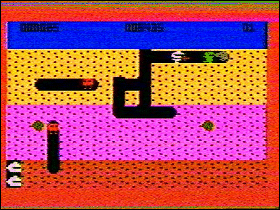 The Game: You are Dig Dug, an intrepid gardener whose soil is infested with pesky Pookas and fire-breathing Fygars. You’re armed with your trusty pump, which you can use to inflate your enemies until, finally, they blow up. But both the Pookas and Fygars can crawl through the ground and can pop out into your tunnels, and if a Fygar sneaks up behind you, he can toast you if you’re not careful. (INTV Corp., 1987)
The Game: You are Dig Dug, an intrepid gardener whose soil is infested with pesky Pookas and fire-breathing Fygars. You’re armed with your trusty pump, which you can use to inflate your enemies until, finally, they blow up. But both the Pookas and Fygars can crawl through the ground and can pop out into your tunnels, and if a Fygar sneaks up behind you, he can toast you if you’re not careful. (INTV Corp., 1987)
Memories: From the ashes of Mattel Electronics, which suffered a multi-million-dollar loss in the 1982-83 crash of the video game industry, several stalwart members of the “Blue Sky Rangers” development team banded together to form INTV Corporation, a leaner, meaner entity that would do what seemed unthinkable in the market climate of the time: keep supporting the Intellivision with new software until further notice. After the NES helped the industry make a comeback, Atari dusted off the 2600 and the stillborn 7800 – which had been ready to hit stores as early as 1984 – and tried to reposition them as budget alternatives to Nintendo’s increasingly ubiquitous machine.
Topper
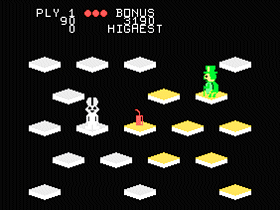 The Game: As Topper the top-hat-wearing turtle, your job is to jump from platform to platform until every platform on the screen is the same color, all without jumping into the empty space beyond the platforms. But as easy as this task may sound, it’s not that easy: rambunctious rabbits are ready to pounce on you, or at the very least keep you from reaching all of the platforms. Random explosives appear on some platforms and you have to avoid that platform until the danger has passed – and not even all of the platforms stay in one place. (Navarone Software, 1986)
The Game: As Topper the top-hat-wearing turtle, your job is to jump from platform to platform until every platform on the screen is the same color, all without jumping into the empty space beyond the platforms. But as easy as this task may sound, it’s not that easy: rambunctious rabbits are ready to pounce on you, or at the very least keep you from reaching all of the platforms. Random explosives appear on some platforms and you have to avoid that platform until the danger has passed – and not even all of the platforms stay in one place. (Navarone Software, 1986)
Memories: The TI 99/4a version of Q*Bert is a decent port of Q*Bert, but on this computer, I much prefer Topper. With tense seconds ticking by as Topper stares down the slow approach of the evil rabbits (who actually look more like evil guys in evil rabbit suits, to be honest), there’s an element of patience and strategy that brings an almost chess-like dimension to what could easily have been just another Q*Bert clone.
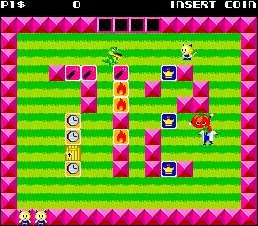 The Game: An adorable kitten (and his twin, in the case of two-player games) runs and jumps around a maze of obstacles, trying to stay out of the clutches of such enemies as an insect in a lab coat, a large and angry-looking tomato, and a crocodile that walks upright. (Further levels add new and even stranger enemies to avoid.) The kitten(s) can push the blocks making up the maze, hopefully smashing an enemy against another block or one of the playfield’s outer walls in the process, temporarily removing that enemy from play. A defeated enemy drops numerous items, including coins, diamonds, and one of several keys needed to open a door allowing access to the next level of the game. (Konami, 1988)
The Game: An adorable kitten (and his twin, in the case of two-player games) runs and jumps around a maze of obstacles, trying to stay out of the clutches of such enemies as an insect in a lab coat, a large and angry-looking tomato, and a crocodile that walks upright. (Further levels add new and even stranger enemies to avoid.) The kitten(s) can push the blocks making up the maze, hopefully smashing an enemy against another block or one of the playfield’s outer walls in the process, temporarily removing that enemy from play. A defeated enemy drops numerous items, including coins, diamonds, and one of several keys needed to open a door allowing access to the next level of the game. (Konami, 1988) The Game: You control a daredevil stunt climber on his trip up the side of a skyscraper in a major metropolitan area, using no ropes, no nets, and nothing but his hands and his feet. Obstacles such as falling jam boxes can cause you to plunge to your death several stories below. When you reach the top – if you reach the top, that is – a helicopter lifts you away to your next challenge. (Nihon Bussan Co., Ltd. [Nichibutsu], 1988)
The Game: You control a daredevil stunt climber on his trip up the side of a skyscraper in a major metropolitan area, using no ropes, no nets, and nothing but his hands and his feet. Obstacles such as falling jam boxes can cause you to plunge to your death several stories below. When you reach the top – if you reach the top, that is – a helicopter lifts you away to your next challenge. (Nihon Bussan Co., Ltd. [Nichibutsu], 1988) The Game: Wonderboy’s girlfriend Tanya has been abducted and it’s up to you to get her back. You’ll have to be pretty crafty to avoid the dangers of Wonderland in this classic Sega platformer. (Activision, 1987)
The Game: Wonderboy’s girlfriend Tanya has been abducted and it’s up to you to get her back. You’ll have to be pretty crafty to avoid the dangers of Wonderland in this classic Sega platformer. (Activision, 1987) The Game: Don’t be a poseur! Skate hard or die trying in the ultimate skateboarding game for the Commodore 64. Practice or compete in five separate events that will lead you over ramps, down streets and even into abandoned pools. (Electronic Arts, 1987)
The Game: Don’t be a poseur! Skate hard or die trying in the ultimate skateboarding game for the Commodore 64. Practice or compete in five separate events that will lead you over ramps, down streets and even into abandoned pools. (Electronic Arts, 1987)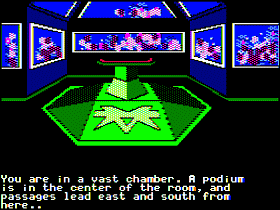 The Game: A prisoner awakens in a cell aboard an alien spaceship, parked on an unknown world. with nothing more than the meal that’s been provided and his wits, the prisoner has to escape his cell, overcome guards and automatic defense system , collect items that could help him escape his captors. The guards always seem to be just around the corner, always helpfully prepared to escort you back to your cell to start again… after a little bit of needless brutality, of course. (Polarware, 1987)
The Game: A prisoner awakens in a cell aboard an alien spaceship, parked on an unknown world. with nothing more than the meal that’s been provided and his wits, the prisoner has to escape his cell, overcome guards and automatic defense system , collect items that could help him escape his captors. The guards always seem to be just around the corner, always helpfully prepared to escort you back to your cell to start again… after a little bit of needless brutality, of course. (Polarware, 1987) The Game: Face not one but two simultaneous opponents in what many consider the apex of Commodore 64 fighting games. IK+ supports one or two players, eighteen different moves, and more fighting action than all of Jean-Claude Van Damme’s movies combined. (System 3, 1987)
The Game: Face not one but two simultaneous opponents in what many consider the apex of Commodore 64 fighting games. IK+ supports one or two players, eighteen different moves, and more fighting action than all of Jean-Claude Van Damme’s movies combined. (System 3, 1987)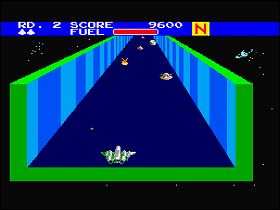 The Game: As the lone pilot daring enough to breach the defenses of Zaxxon’s space stronghold yet again, you take on a fleet of perimeter fighters, some of whom helpfully leave power-ups behind when destroyed. Then it’s into the space base once more, bristling with gun emplacements, fuel tanks that gas up your fighter when they’re shot (we haven’t quite worked that one out either), and walls that you can run face-first if you’re at just the wrong altitude. Just beyond the walls of the base lies the new and improved Zaxxon itself; if you survive that encounter, you begin again. (Sega, 1987)
The Game: As the lone pilot daring enough to breach the defenses of Zaxxon’s space stronghold yet again, you take on a fleet of perimeter fighters, some of whom helpfully leave power-ups behind when destroyed. Then it’s into the space base once more, bristling with gun emplacements, fuel tanks that gas up your fighter when they’re shot (we haven’t quite worked that one out either), and walls that you can run face-first if you’re at just the wrong altitude. Just beyond the walls of the base lies the new and improved Zaxxon itself; if you survive that encounter, you begin again. (Sega, 1987)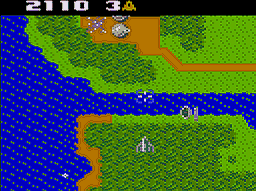 The Game: As the commander of a sleek Solvalou fighter, you’re deep into enemy territory, shooting their disc-shaped fighters out of the sky, bombing ground installations and artillery nests, bombing tanks, and trying to destroy the mothership. As you progress further behind enemy lines, heavier aircraft and more versatile and deadly ground-based defenses become the norm. Also look out for tumbling airborne mirrors – they’re impervious to your fire, but you’re toast if you fly right into them. (Atari, 1984; released circa 1987)
The Game: As the commander of a sleek Solvalou fighter, you’re deep into enemy territory, shooting their disc-shaped fighters out of the sky, bombing ground installations and artillery nests, bombing tanks, and trying to destroy the mothership. As you progress further behind enemy lines, heavier aircraft and more versatile and deadly ground-based defenses become the norm. Also look out for tumbling airborne mirrors – they’re impervious to your fire, but you’re toast if you fly right into them. (Atari, 1984; released circa 1987)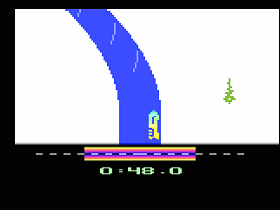 The Game: The Olympic torch is the warmest thing to be found in this multi-event recreation of the Winter Olympics. Downhill skiing, luge, slalom skiing and other events are represented here, and players can even pick which country they’re representing as they go for the gold. (Epyx, 1987)
The Game: The Olympic torch is the warmest thing to be found in this multi-event recreation of the Winter Olympics. Downhill skiing, luge, slalom skiing and other events are represented here, and players can even pick which country they’re representing as they go for the gold. (Epyx, 1987)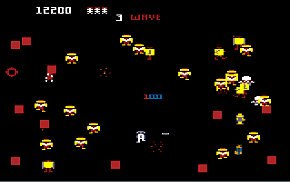 The Game: In the year 2084, all hell has broken loose on Earth. Robotic servants, created to perform dangerous tasks and defend their human creators, have decided they can do without their masters. The robots have evolved into new and terrifying varieties – the ever-multiplying Ground Roving UNit Terminators (GRUNTs), indestructible Hulks, self-replicating Quarks and Tanks, and most horrfying of all, the Brain robots, which capture humans and reprogram them into super-fast killing machines. And the only thing protecting the last remaining survivors of homo sapiens is your strength, endurance and cunning. (Atari, 1984 [released in 1987])
The Game: In the year 2084, all hell has broken loose on Earth. Robotic servants, created to perform dangerous tasks and defend their human creators, have decided they can do without their masters. The robots have evolved into new and terrifying varieties – the ever-multiplying Ground Roving UNit Terminators (GRUNTs), indestructible Hulks, self-replicating Quarks and Tanks, and most horrfying of all, the Brain robots, which capture humans and reprogram them into super-fast killing machines. And the only thing protecting the last remaining survivors of homo sapiens is your strength, endurance and cunning. (Atari, 1984 [released in 1987]) The Game: It’s your big chance to qualify for the big race at one of four tracks: the oval test track, Seaside, Suzuka, and the Mt. Fuji track from the original Pole Position. First, you try to get through the qualifying heat, racking up laps around the track as fast you can and accumulating as few wrecks as possible. If you pass muster, then you get to try it again with other cars on the track! (Atari, 1984; released circa 1987)
The Game: It’s your big chance to qualify for the big race at one of four tracks: the oval test track, Seaside, Suzuka, and the Mt. Fuji track from the original Pole Position. First, you try to get through the qualifying heat, racking up laps around the track as fast you can and accumulating as few wrecks as possible. If you pass muster, then you get to try it again with other cars on the track! (Atari, 1984; released circa 1987)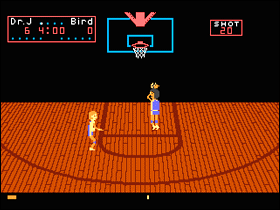 The Game: Dr. J and Larry Bird take to the hardwood for one-on-one half-court basketball action. Each player has his own signature moves, from lay-ups to three-point shots to steals. One or two players can play to a predetermined score or to a time limit. (Atari [under license from Electronic Arts], 1987)
The Game: Dr. J and Larry Bird take to the hardwood for one-on-one half-court basketball action. Each player has his own signature moves, from lay-ups to three-point shots to steals. One or two players can play to a predetermined score or to a time limit. (Atari [under license from Electronic Arts], 1987)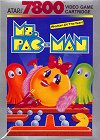 The Game: As the bride of that most famous of single-celled omniphage life forms, your job is pretty simple – eat all the dots, gulp the large blinking dots in each corner of the screen and eat the monsters while they’re blue, and avoid the monsters the rest of the time. Occasionally various fruits and other foods will bounce through the maze, and you can gobble those for extra points. (Atari, 1984; released circa 1987)
The Game: As the bride of that most famous of single-celled omniphage life forms, your job is pretty simple – eat all the dots, gulp the large blinking dots in each corner of the screen and eat the monsters while they’re blue, and avoid the monsters the rest of the time. Occasionally various fruits and other foods will bounce through the maze, and you can gobble those for extra points. (Atari, 1984; released circa 1987)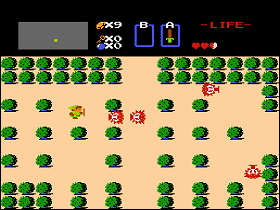 The Game: Link wanders the kingdom of Hyrule, attempting to defeat the minions of the evil Ganon and trying to gather the weapons, tools, and items he will need to free the kingdom. Most vital on his quest is the recovery of all the pieces of the magical Triforce, the most powerful force that can be brought against Ganon. But as each piece is recovered and each part of the quest is completed, the next leg of the journey is even more difficult. (Nintendo, 1987)
The Game: Link wanders the kingdom of Hyrule, attempting to defeat the minions of the evil Ganon and trying to gather the weapons, tools, and items he will need to free the kingdom. Most vital on his quest is the recovery of all the pieces of the magical Triforce, the most powerful force that can be brought against Ganon. But as each piece is recovered and each part of the quest is completed, the next leg of the journey is even more difficult. (Nintendo, 1987)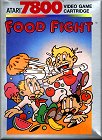

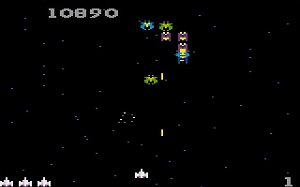 The Game: Commanding a small fleet of sleek fighter ships, you’re up against an alien invasion, arriving in wave after unfriendly wave. Alien fighters resemble butterflies and bees, but the real prize is the handful of motherships which arrives with each wave. Capable of taking two hits – the first weakens them and turns them dark blue, the second destroys them – the motherships also come equipped with a tractor beam with which to snare your fighters. But if one of your fighters is captured, and you can destroy the mothership which is towing it, your wayward fighter will be returned, doubling your firepower. (Atari, 1984; released circa 1987)
The Game: Commanding a small fleet of sleek fighter ships, you’re up against an alien invasion, arriving in wave after unfriendly wave. Alien fighters resemble butterflies and bees, but the real prize is the handful of motherships which arrives with each wave. Capable of taking two hits – the first weakens them and turns them dark blue, the second destroys them – the motherships also come equipped with a tractor beam with which to snare your fighters. But if one of your fighters is captured, and you can destroy the mothership which is towing it, your wayward fighter will be returned, doubling your firepower. (Atari, 1984; released circa 1987)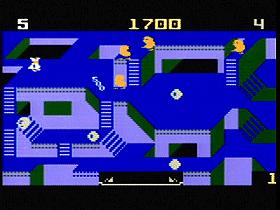 The Game: Chef Peter Pepper is back, and he’s been served up a second helping of inedible trouble. Roaming the vast, maze-like expanses of Ray’s Diner, the chef has to round up the scattered ingredients of dinner before he finds himself on the menu. For every four screen he clears, Peter Pepper gets a chance to catch more ingredients in a bonus round (but must avoid the flashing ingredients at all costs). The chef is also still armed with his trusty pepper shaker to stun his enemies briefly, and he can still replenish his short supply of pepper when bonus items appear. (INTV Corp., 1987)
The Game: Chef Peter Pepper is back, and he’s been served up a second helping of inedible trouble. Roaming the vast, maze-like expanses of Ray’s Diner, the chef has to round up the scattered ingredients of dinner before he finds himself on the menu. For every four screen he clears, Peter Pepper gets a chance to catch more ingredients in a bonus round (but must avoid the flashing ingredients at all costs). The chef is also still armed with his trusty pepper shaker to stun his enemies briefly, and he can still replenish his short supply of pepper when bonus items appear. (INTV Corp., 1987) The Game: As the pilot of a lone space cruiser, you must try to clear the spaceways of a swarm of free-floating asteroids, but the job isn’t easy – Newton’s laws of motion must be obeyed, even by asteroids. When you blow a big rock into
The Game: As the pilot of a lone space cruiser, you must try to clear the spaceways of a swarm of free-floating asteroids, but the job isn’t easy – Newton’s laws of motion must be obeyed, even by asteroids. When you blow a big rock into 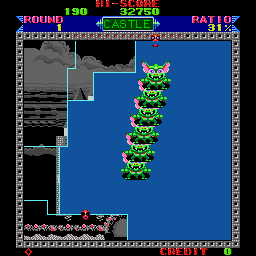 The Game: You are a marker, trying to claim as much of the playing field as you can by enclosing areas of it. Drawing your boundaries faster is safer, but yields fewer points. A slower draw, which leaves you vulnerable to attack from the Qix Dragon and the Sparx, gives you many more points upon the completion of an enclosed area. If the jumpy Qix Dragon touches your marker or an uncompleted boundary you are drawing, you lose a “life” and start again. And the Sparx, which travel only along the edges of the playing field and along the boundaries of areas of the screen you’ve already enclosed, can destroy you by touching your marker. And if you linger too long, a fuse will begin burning at the beginning of your unfinished boundary, and will eventually catch up with you. (Taito, 1987)
The Game: You are a marker, trying to claim as much of the playing field as you can by enclosing areas of it. Drawing your boundaries faster is safer, but yields fewer points. A slower draw, which leaves you vulnerable to attack from the Qix Dragon and the Sparx, gives you many more points upon the completion of an enclosed area. If the jumpy Qix Dragon touches your marker or an uncompleted boundary you are drawing, you lose a “life” and start again. And the Sparx, which travel only along the edges of the playing field and along the boundaries of areas of the screen you’ve already enclosed, can destroy you by touching your marker. And if you linger too long, a fuse will begin burning at the beginning of your unfinished boundary, and will eventually catch up with you. (Taito, 1987)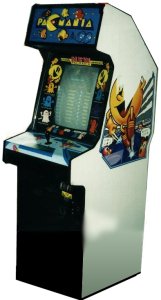 The Game: As a round yellow creature consisting of a mouth and nothing else, you maneuver around relatively simple mazes, gobbling small dots and evading five colorful monsters who can eat you on contact. In four corners of the screen,
The Game: As a round yellow creature consisting of a mouth and nothing else, you maneuver around relatively simple mazes, gobbling small dots and evading five colorful monsters who can eat you on contact. In four corners of the screen,  The Game: Commanding a small fleet of sleek fighter ships, you’re up against an alien invasion, arriving in wave after unfriendly wave. Alien fighters resemble butterflies and bees, but the real prize is the handful of motherships which arriveswith each wave. Capable of taking two hits – the first weakens them and turns them dark blue, the second destroys them – the motherships also come equipped with a tractor beam with which to snare your fighters. But if one of your fighters is captured, and you can destroy the mothership which is towing it, your wayward fighter will be returned, doubling your firepower. (Namco, 1987)
The Game: Commanding a small fleet of sleek fighter ships, you’re up against an alien invasion, arriving in wave after unfriendly wave. Alien fighters resemble butterflies and bees, but the real prize is the handful of motherships which arriveswith each wave. Capable of taking two hits – the first weakens them and turns them dark blue, the second destroys them – the motherships also come equipped with a tractor beam with which to snare your fighters. But if one of your fighters is captured, and you can destroy the mothership which is towing it, your wayward fighter will be returned, doubling your firepower. (Namco, 1987) The Game: Your sleek spacecraft is launched from a base installation on Halley’s Comet (!). Your mission is to scout various bodies in the solar system – both planets and moons – which meet strictly defined criteria as dispensed by the computer. In some cases you must land, in others you must simply achieve orbit. You must learn to navigate the solar system using the constellations of the Zodiac, and learn to judge distance so you won’t overshoot your target (and therefore exceed your allotted mission time) with brief bursts of your faster-than- light drive. You climb in the ranks as you complete more missions. (Interscope, 1986)
The Game: Your sleek spacecraft is launched from a base installation on Halley’s Comet (!). Your mission is to scout various bodies in the solar system – both planets and moons – which meet strictly defined criteria as dispensed by the computer. In some cases you must land, in others you must simply achieve orbit. You must learn to navigate the solar system using the constellations of the Zodiac, and learn to judge distance so you won’t overshoot your target (and therefore exceed your allotted mission time) with brief bursts of your faster-than- light drive. You climb in the ranks as you complete more missions. (Interscope, 1986)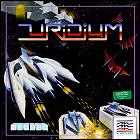 The Game: Destroy massive motherships while fighting waves of enemies and avoiding obstacles at breakneck speeds in this groundbreaking horizontal SHMUP. There’ll be time to rest when you’re dead. (Hewson, 1986)
The Game: Destroy massive motherships while fighting waves of enemies and avoiding obstacles at breakneck speeds in this groundbreaking horizontal SHMUP. There’ll be time to rest when you’re dead. (Hewson, 1986) using WordPress and
using WordPress and